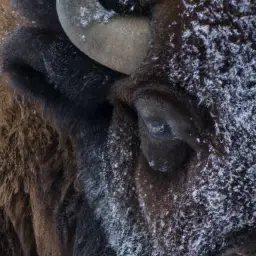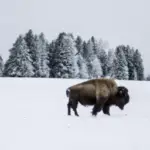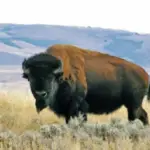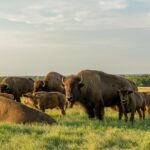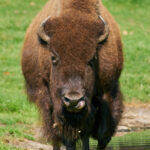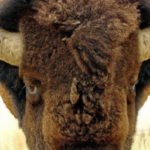Imagine standing in the freezing wilderness, surrounded by snow-covered plains and ice-capped mountains. You can see your breath in the frigid air as you marvel at the incredible resilience of the bison. These majestic creatures have adapted to survive in the most bone-chilling temperatures, defying the limits of what we thought was possible. In this article, we will explore just how cold a bison can endure and uncover the extraordinary mechanisms they possess to brave the harsh winter climates. Brace yourself for an awe-inspiring journey into the world of these cold-adapted giants.
Understanding the Bison’s Natural Habitat
Details on natural surroundings where bison thrive
Bison, also known as American buffalo, inhabit a variety of ecosystems, ranging from grasslands and prairies to woodlands and mixed-grass prairies. They are most commonly found in North America, with significant populations in the United States and Canada. The open grasslands provide an excellent feeding ground for these large herbivores, allowing them to graze on a diverse range of vegetation. Bison thrive in areas where there is an abundant supply of grass, which serves as their primary food source.
Understanding climate conditions in bison habitats
Bison have adapted to various climate conditions, including both hot summers and cold winters. In general, the climates where bison reside experience distinct seasonal changes. During the summer months, the temperatures can reach high levels, often exceeding 90 degrees Fahrenheit (32 degrees Celsius). These warm conditions allow the bison to graze and build up fat reserves for the impending winter.
How a bison habitat is affected by climate changes
Climate change poses significant challenges to the bison habitat. Rising temperatures, extreme weather events, and changing precipitation patterns can disrupt the delicate balance that exists between bison and their environment. For example, prolonged droughts can reduce the availability of grass, leading to food scarcity for bison. Additionally, unpredictable weather patterns can result in harsher winters and longer periods of extreme cold, making it more difficult for bison to survive. The impact of climate change on the bison’s natural habitat emphasizes the need for conservation efforts and proactive management strategies to ensure their long-term survival.
Bison’s Anatomical Structure and Adaptations for Winter
Adaptations in anatomy for survival in cold
Bison have several unique anatomical adaptations that help them survive the harsh winter conditions. One of the most notable features is their large, muscular bodies, which provide insulation against the cold. Their thick skin, covered with a dense coat of fur, helps to retain body heat and protect them from the biting cold. Additionally, bison have a hump of muscle and fat on their shoulders, which acts as an energy reserve during the winter months when food is scarce.
Role of fur and fat in thermoregulation
The fur of a bison consists of two distinct layers: a coarse outer layer and a soft, insulating underlayer. This dual-layered fur helps to trap heat close to the body, providing effective insulation against the cold. The fur also repels moisture, allowing bison to stay dry in snowy conditions. Furthermore, the layer of fat stored in their hump and throughout their bodies acts as an energy source during the winter, serving as an additional layer of insulation and providing necessary sustenance when food is scarce.
Unique characteristics aiding in winter survival
Bison possess several unique characteristics that enable them to survive in winter. Their large head and powerful neck muscles allow them to forage for food by using their massive heads to push through dense snow. Additionally, bison have a well-developed sense of smell, which helps them locate food sources buried beneath the snow. They also have a specialized digestive system that allows them to extract maximum nutrition from the tough, coarse grasses they consume during the winter months.
Bison Behavior During Winter
Behaviour changes during harsh cold temperatures
During the winter months, when temperatures drop significantly, the behavior of bison undergoes noticeable changes. One of the most significant changes is their tendency to gather in smaller groups or herds. By clustering together, bison can conserve body heat and protect one another from the harsh elements. They exhibit a more sedentary lifestyle, minimizing their movements to conserve energy. Furthermore, bison tend to seek shelter in areas with natural windbreaks, such as valleys, slopes, or dense vegetation.
How bison search for food in snow
As snow covers their grazing grounds, bison adapt their feeding behaviors to find food sources beneath the snow. Their large heads, equipped with powerful neck muscles, allow them to use their sheer strength to create pathways through the snow. Once they reach the vegetation below, they use their elongated tongues to grasp and pull out the grass. This unique feeding behavior enables bison to access their primary food source, despite the challenging winter conditions.
Migratory behavior in relation to climate changes
Bison often exhibit migratory behavior in response to changing climate conditions. In the face of harsh winters or food scarcity, they may undertake long-distance migrations in search of more favorable habitats. These migrations can involve significant distances, as bison move across vast landscapes to find areas with better food resources and milder weather conditions. The ability to adapt their behavior and mobility is crucial for bison populations to survive in the face of climate change and changing environmental conditions.
Understanding the Concept of Thermoregulation in Bison
How bison maintain their body temperature
Bison have a remarkable ability to regulate their body temperature to cope with both hot summers and cold winters. In winter, they employ thermoregulation techniques to conserve heat and maintain a stable core temperature. One method is the constriction of blood vessels near the skin’s surface, reducing blood flow to the extremities and minimizing heat loss. They also adopt a more sedentary lifestyle, reducing the overall amount of energy expended and conserving body heat.
Factors contributing to efficient thermoregulation
Several factors contribute to the efficiency of thermoregulation in bison. Their dense fur, as previously mentioned, acts as insulation, trapping body heat close to the skin. The layer of fat in their bodies serves as an energy reserve and insulation against the cold. Additionally, the bison’s low surface area-to-volume ratio helps reduce heat loss, enabling them to retain warmth more effectively. Together, these adaptations allow bison to endure frigid temperatures and maintain their body temperature within a viable range.
Importance of thermoregulation for survival
Efficient thermoregulation is vital for the survival of bison during winter. By maintaining a stable body temperature, bison can conserve energy and allocate resources towards their essential bodily functions, such as digestion and immune system maintenance. Failure to regulate body temperature properly can lead to significant physiological stress, compromising the overall health and survival of these magnificent animals.
How Cold Can a Bison Tolerate
Minimum temperature a bison can withstand
Bison are known for their ability to withstand extreme cold temperatures. They can tolerate temperatures as low as -50 degrees Fahrenheit (-46 degrees Celsius) and have been observed surviving in freezing conditions for extended periods. Their thick fur, fat reserves, and adaptations for thermoregulation enable them to withstand these frigid temperatures that would be fatal for many other species.
Impacts of prolonged exposure to extreme cold
While bison are well-adapted to cold climates, prolonged exposure to extreme cold can have adverse effects on their well-being. In severe winter conditions, limited access to food due to deep snow cover may result in malnutrition and weight loss. Additionally, the prolonged cold can lead to frostbite on their extremities, such as their ears and tails. Therefore, although bison can tolerate extremely cold temperatures, it is essential for them to have access to adequate food and shelter to cope with prolonged exposure to harsh winter conditions.
Survival rates of bison in cold habitats
Despite the challenges presented by cold habitats, bison have demonstrated remarkable survival rates in these environments. Their ability to adapt their behavior, find food sources beneath the snow, and withstand freezing temperatures contribute to their overall resilience. Additionally, conservation efforts, habitat management, and monitoring programs play a crucial role in ensuring the continued survival and well-being of bison populations in cold habitats.
Bison Health Concerns in Severe Winters
Common health problems faced by bison during winters
Severe winters can pose health challenges for bison populations. One of the most significant concerns is malnutrition due to limited access to food. The deep snow cover makes it challenging for bison to find sufficient vegetation, leading to weight loss and weakened immune systems. Another health concern is frostbite, particularly in the extremities, which can result in tissue damage and secondary infections. Respiratory infections are also common, as cold temperatures and damp conditions facilitate the spread of diseases among the bison.
Effects of severe cold on bison nutritional requirements
During severely cold winters, bison face increased nutritional requirements to maintain their energy levels and body condition. The need to conserve energy and thermoregulate in freezing temperatures intensifies their dietary demands. With limited access to food sources rich in nutrients, bison may experience deficiencies in essential minerals, vitamins, and energy. Addressing their increased nutritional needs becomes vital to ensure the overall health and well-being of the bison during severe winter conditions.
Importance of adequate food supply for survival in winter
An adequate food supply is crucial for the survival of bison during winter. Access to nutritious vegetation helps maintain the overall health, body condition, and energy levels of the bison population. Conservation efforts that focus on preserving and restoring suitable grazing habitats are essential to ensure an adequate food supply for bison during the harsh winter months. This includes managing grazing patterns, maintaining diverse plant communities, and restoring degraded grasslands to sustain healthy bison populations in winter conditions.
Impact of Snow and Ice on Bison Survival
Challenges posed by snow and ice
Snow and ice pose numerous challenges to the survival of bison during winter. Deep snow cover can limit their mobility and foraging capabilities. Navigating through thick snow requires more energy expenditure and can result in exhaustion. Ice patches also pose a risk of injury, making movement more treacherous for these large, heavy animals. Furthermore, snow cover can conceal food sources, making it more difficult for bison to locate and access their primary food supply.
Bison strategies to cope with snowy conditions
Bison employ various strategies to cope with snowy conditions. Their powerful bodies and strong neck muscles allow them to create paths by pushing through the snow with their heads. This behavior uncovers vegetation for feeding and helps other herd members navigate through the terrain. Additionally, bison utilize their well-developed sense of smell to detect buried food sources beneath the snow, allowing them to find sustenance even when access to grazing is limited. These strategies enable bison to adapt to snowy conditions and ensure their survival during winter.
Reports of bison survival in ice-bound environments
Despite the challenges posed by ice-bound environments, there have been reports of bison successfully surviving in these conditions. Their ability to endure freezing temperatures, break through ice to access water, and adapt their grazing patterns allows them to thrive even in the harshest environments. These reports highlight the remarkable resilience and adaptability of bison in the face of challenging winter conditions.
Effect of Climate Change on Bison Survival in Winter
Long-term impacts of climate change on bison populations
Climate change poses significant long-term impacts on bison populations during winter. Rising temperatures can lead to altered weather patterns, including shifts in snowfall and precipitation. These changes can disrupt the availability of food sources and alter the timing of seasonal events, such as migration and breeding. Additionally, warmer winter temperatures may result in a decrease in the duration and severity of cold periods, impacting the bison’s ability to adapt their behavior and physiology for survival.
Changes in bison habitat due to warming temperatures
The warming temperatures associated with climate change have the potential to affect the bison’s habitat. Shifts in vegetation patterns, changes in the composition of plant communities, and alterations in ecosystem dynamics can impact the availability and quality of their food sources. These changes may require bison populations to modify their feeding behaviors, adjust migration patterns, or potentially seek out new habitats to ensure their survival.
Adaptive changes in bison behavior due to climate change
Bison populations are known for their ability to adapt to changing environmental conditions. In response to climate change, bison may undergo behavioral changes, such as altering their feeding preferences or adjusting their migration routes and timing. These adaptive changes in behavior allow bison to navigate the challenges posed by climate change and increase their chances of survival in the face of uncertain and evolving environmental conditions.
Bison Management Techniques for Winter Survival
Role of bison management in enhancing winter survival
Effective bison management practices play a crucial role in enhancing winter survival. Conservation efforts that focus on maintaining suitable habitat conditions, including adequate food supply and shelter, are critical for supporting bison populations during the harsh winter months. Furthermore, implementing grazing management strategies that promote sustainable forage utilization and minimize overgrazing can ensure the availability of nutritious vegetation for bison survival throughout the winter.
Effective herd management practices in cold climates
Herd management practices in cold climates should prioritize providing adequate food and shelter for bison populations. Monitoring forage availability, assessing winter range conditions, and implementing supplementary feeding programs when necessary can help mitigate the challenges brought on by severe winters. Additionally, managing herd size to prevent overgrazing and reduce competition for limited resources is essential for the long-term health and survival of bison populations in cold climates.
Importance of veterinary care in winter for bison health
Veterinary care plays a vital role in ensuring the health and well-being of bison during winter. Regular health monitoring, vaccinations, and disease prevention measures are essential to prevent the spread of infectious diseases in crowded wintering grounds. Addressing potential health concerns, such as malnutrition or frostbite, requires veterinary intervention and management. By providing adequate veterinary care, bison populations can withstand the challenges posed by severe winters and maintain overall health and resilience.
How Would Bison’s Ability to Survive in Extreme Cold Temperatures Affect Their Potential Extinction?
How would Bison’s ability to survive in extreme cold temperatures affect their potential extinction? If bison went extinct, what would happen if bison went extinct ecosystems would undergo significant changes. These resilient animals are adapted to withstand harsh winters, providing crucial ecological services. Their extinction could disrupt food chains, alter vegetation dynamics, and impact other species dependent on their grazing and movement patterns. Protecting bison populations safeguards biodiversity and helps maintain the balance of fragile ecosystems.
Case Studies of Bison Survival in Extremely Cold Conditions
Survival instances of bison in Arctic conditions
Several instances showcase the remarkable survival of bison in Arctic conditions. In areas such as Alaska and Northern Canada, bison populations have successfully adapted to thrive in extreme cold and harsh winter climates. These populations have demonstrated their ability to withstand temperatures well below freezing, find food sources under snow cover, and endure the challenges posed by Arctic conditions. These case studies highlight the tenacity and adaptability of bison in some of the most challenging environments on Earth.
Comparison with survival of other cold-tolerant species
When comparing the survival of bison with other cold-tolerant species, it becomes evident that bison possess exceptional adaptations for winter survival. Their large size, dense fur, and thermoregulatory mechanisms set them apart from many other animals. While various species have evolved to tolerate cold climates, bison’s ability to endure extremely low temperatures, find buried food sources, and adapt their behavior make them particularly well-suited to survive in severe winter conditions.
Learnings from Bison’s survival in cold environments
The survival of bison in cold environments provides valuable insights and learnings for conservation efforts and ecosystem management. Studying their adaptations, behavioral changes, and resilience in extreme conditions can inform strategies aimed at preserving other cold-tolerant species and managing ecosystems effectively. The lessons learned from bison’s survival in cold environments contribute to our understanding of the complex interactions between wildlife, climate change, and habitat preservation, guiding conservation efforts to ensure the long-term survival of these majestic creatures.
In conclusion, understanding the bison’s natural habitat, anatomical adaptations for winter, behavior during cold temperatures, thermoregulation mechanisms, and their tolerance to extreme cold is crucial for their survival. Climate change, snow, and ice pose challenges to bison populations, which require effective management techniques and conservation efforts. By studying their adaptations and successes in severe winter conditions, we can learn valuable insights to protect and preserve these iconic creatures for future generations.

